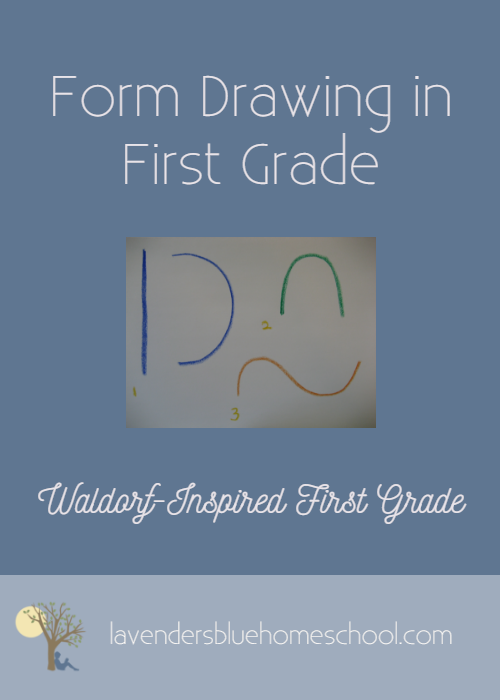Form Drawing in First Grade
Form drawing is a unique subject in the Waldorf curriculum. It’s the drawing of patterns, or forms, beginning with the straight line and curve on the first day of first grade and progressing through to very complicated Celtic knots by fourth grade and freehand geometry in fifth. Form drawing can be described as capturing movement on paper. It’s interdisciplinary and touches on far-ranging subjects such as history, geography, movement, drawing, and geometry. Interesting stuff!
Form drawing first day | Lavender's Blue Homeschool
Form drawing can be taught as a main lesson subject or as a weekly lesson. Homeschoolers often begin first grade with a 2-week form drawing block and then continue with weekly lessons through the early grades. The straight line and the curve that you teach on the first day of school are the basis for all of the other forms, including the forms of the numbers and letters.
First graders typically learn several different standing forms including spirals, figure-eights, stars, circles, squares, and other geometric shapes. Next come the running forms. These are patterns that continue across the page such as a series of loops, zigzags, or a stepwise pattern. Some teachers also begin mirrored forms in first grade. In a mirrored form, you draw the form on one side of a horizontal or vertical axis and then complete the symmetry on the other side (the axis may or may not be drawn).
Form drawing spiral | Lavender's Blue Homeschool
There are several reasons to teach form drawing. One is that it strengthens the child’s fine motor and drawing abilities in general and helps to improve handwriting. Form drawing can be used to teach print and cursive and to help a child who is reversing letters or numbers. Another is that it provides challenges in concentrating, crossing the midline, spatial orientation, and recreating complex patterns and symmetries. The forms themselves are beautiful and are often patterns that are found in very ancient art and architecture. Learning to draw forms from around the world such as those found on Greek pottery or Indian mandalas is a connection to those cultures that you can’t get from reading a textbook. Finally, form drawing can be used to work with the four temperaments.
To teach form drawing, start by practicing yourself. Adults usually enjoy form drawing as well! It’s a fun challenge and can be a soothing and meditative activity. To get started, all you need is paper and beeswax stick crayons. I like having a spiral Strathmore drawing pad for my own drawing and form drawing practice.
When you work with your first grader, it can help to have a little story or image to play with. What movement or shape do you see in the form that you’ll draw? Is it the flight of a bird, a mountain, a mushroom, crashing waves, or the stomping feet of a giant? Use images from nature or your fairy tales to inspire you. Tell your child the little story while you slowly and carefully draw the form onto a large chalkboard or paper.
Form drawing castle | Lavender's Blue Homeschool
Begin your form drawing lesson with lots of movement. Explore the ways that you can experience the form in your body. You might walk the form, skip or stomp it. You might create the form with a jumprope, a pile of pennies, or a lump of clay. You could trace it on each other’s backs, in a sand tray, or outside in the dirt with a stick. You could be the waves, bird, bee, grasses, hopping frog, straight line, and curve with your whole body. You can practice a form with a paintbrush, fingerpainting, bread dough, or sidewalk chalk. Choose two or three ways to practice a new form - your lessons don’t ever need to be boring, but don’t exhaust yourselves either!
When you have the feeling of the form in movement, practice drawing it. You can trace the form with your finger in the air or practice on paper or the chalkboard. It’s good to try form drawing with your feet and non-dominant hand from time to time too! The last step is for your child to draw the form into his main lesson book.
Form drawing loops | Lavender's Blue Homeschool
At the end of the year, your child will be thrilled to look through the book and see what progress he made in first grade!
Did you know?
The Lavender's Blue Homeschool First Grade curriculum is a complete Waldorf-inspired curriculum that includes all the form drawing you need for a year of first grade at home.





